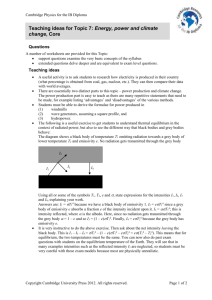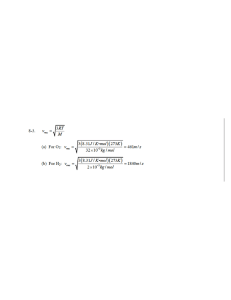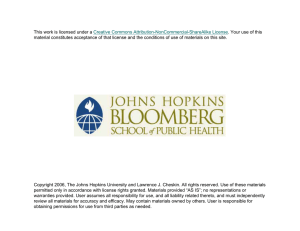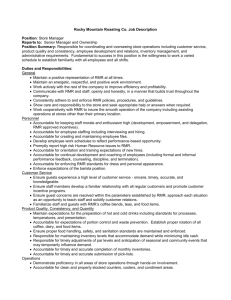2533
advertisement
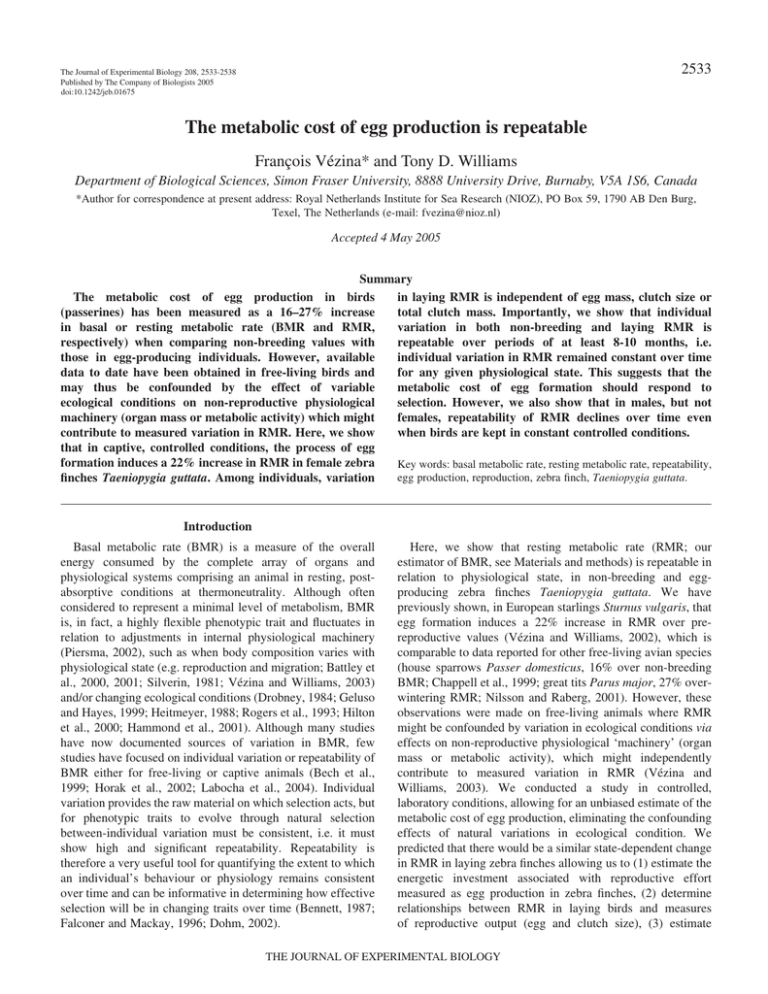
2533 The Journal of Experimental Biology 208, 2533-2538 Published by The Company of Biologists 2005 doi:10.1242/jeb.01675 The metabolic cost of egg production is repeatable François Vézina* and Tony D. Williams Department of Biological Sciences, Simon Fraser University, 8888 University Drive, Burnaby, V5A 1S6, Canada *Author for correspondence at present address: Royal Netherlands Institute for Sea Research (NIOZ), PO Box 59, 1790 AB Den Burg, Texel, The Netherlands (e-mail: fvezina@nioz.nl) Accepted 4 May 2005 Summary The metabolic cost of egg production in birds in laying RMR is independent of egg mass, clutch size or (passerines) has been measured as a 16–27% increase total clutch mass. Importantly, we show that individual in basal or resting metabolic rate (BMR and RMR, variation in both non-breeding and laying RMR is respectively) when comparing non-breeding values with repeatable over periods of at least 8-10 months, i.e. individual variation in RMR remained constant over time those in egg-producing individuals. However, available for any given physiological state. This suggests that the data to date have been obtained in free-living birds and may thus be confounded by the effect of variable metabolic cost of egg formation should respond to ecological conditions on non-reproductive physiological selection. However, we also show that in males, but not females, repeatability of RMR declines over time even machinery (organ mass or metabolic activity) which might when birds are kept in constant controlled conditions. contribute to measured variation in RMR. Here, we show that in captive, controlled conditions, the process of egg formation induces a 22% increase in RMR in female zebra Key words: basal metabolic rate, resting metabolic rate, repeatability, egg production, reproduction, zebra finch, Taeniopygia guttata. finches Taeniopygia guttata. Among individuals, variation Introduction Basal metabolic rate (BMR) is a measure of the overall energy consumed by the complete array of organs and physiological systems comprising an animal in resting, postabsorptive conditions at thermoneutrality. Although often considered to represent a minimal level of metabolism, BMR is, in fact, a highly flexible phenotypic trait and fluctuates in relation to adjustments in internal physiological machinery (Piersma, 2002), such as when body composition varies with physiological state (e.g. reproduction and migration; Battley et al., 2000, 2001; Silverin, 1981; Vézina and Williams, 2003) and/or changing ecological conditions (Drobney, 1984; Geluso and Hayes, 1999; Heitmeyer, 1988; Rogers et al., 1993; Hilton et al., 2000; Hammond et al., 2001). Although many studies have now documented sources of variation in BMR, few studies have focused on individual variation or repeatability of BMR either for free-living or captive animals (Bech et al., 1999; Horak et al., 2002; Labocha et al., 2004). Individual variation provides the raw material on which selection acts, but for phenotypic traits to evolve through natural selection between-individual variation must be consistent, i.e. it must show high and significant repeatability. Repeatability is therefore a very useful tool for quantifying the extent to which an individual’s behaviour or physiology remains consistent over time and can be informative in determining how effective selection will be in changing traits over time (Bennett, 1987; Falconer and Mackay, 1996; Dohm, 2002). Here, we show that resting metabolic rate (RMR; our estimator of BMR, see Materials and methods) is repeatable in relation to physiological state, in non-breeding and eggproducing zebra finches Taeniopygia guttata. We have previously shown, in European starlings Sturnus vulgaris, that egg formation induces a 22% increase in RMR over prereproductive values (Vézina and Williams, 2002), which is comparable to data reported for other free-living avian species (house sparrows Passer domesticus, 16% over non-breeding BMR; Chappell et al., 1999; great tits Parus major, 27% overwintering RMR; Nilsson and Raberg, 2001). However, these observations were made on free-living animals where RMR might be confounded by variation in ecological conditions via effects on non-reproductive physiological ‘machinery’ (organ mass or metabolic activity), which might independently contribute to measured variation in RMR (Vézina and Williams, 2003). We conducted a study in controlled, laboratory conditions, allowing for an unbiased estimate of the metabolic cost of egg production, eliminating the confounding effects of natural variations in ecological condition. We predicted that there would be a similar state-dependent change in RMR in laying zebra finches allowing us to (1) estimate the energetic investment associated with reproductive effort measured as egg production in zebra finches, (2) determine relationships between RMR in laying birds and measures of reproductive output (egg and clutch size), (3) estimate THE JOURNAL OF EXPERIMENTAL BIOLOGY 2534 F. Vézina and T. D. Williams repeatability for non-breeding and laying RMR to evaluate the level of stability of this trait within individuals and between breeding attempts, and (4) investigate the effect of time on repeatability of RMR over short (8 days) and long (10 months) timescales. Materials and methods Animal husbandry Zebra finches (Taeniopygia guttata, Vieillot) were kept in controlled environmental conditions (temperature 19°-23°C; humidity 35%–55%; constant light intensity, 14·h:10·h L:D, with lights on at 0800·h). All birds were maintained on a mixed-seed diet (Panicum and white millet, 50:50; approximately 12.0% protein, 4.7% lipid; Jamieson’s Pet Food, Vancouver, BC, Canada) with water, grit and cuttlefish bone ad libitum, and were given a multivitamin supplement in the drinking water once per week. All non-breeding birds were kept with the same sex in 614641·cm cages. Birds forming breeding pairs were chosen randomly and were housed in the same type of cage and provided with an external nest box (11.5·cm11.5·cm11.5·cm). Nest boxes were checked daily between 1000–1200·h, and all new eggs were weighed (to ±0.001·g) and numbered. A clutch was considered complete after two consecutive days with no new eggs. All breeding pairs had access to an egg food supplement replaced daily (20.3% protein, 6.6% lipid). All experiments and animal husbandry were carried out under a Simon Fraser University Animal Care Committee permit (692B-94), following the guidelines of the Canadian Committee on Animal Care. Measurement of resting metabolic rate Basal metabolic rate is defined as the energy consumed by a resting post-absorptive animal during the inactive phase of the circadian cycle at a temperature within the thermoneutral range for the animal (Commission for Thermal Physiology of the IUPS, 2001). However, since laying birds are producing eggs, they have to be considered to be in an ‘active physiological state’ (Vézina and Williams, 2002). We therefore consider the term resting metabolic rate more appropriate in the present study. All resting metabolic rate (RMR) measurements were completed using a flow-through respirometry set-up (Sable Systems International; oxygen analyzer model FC-1, CO2 analyser model CA-1) described elsewhere (Vézina et al., 2003). Birds were taken from their cages within 10–15·min after lights were turned off, their body mass measured (±0.1·g), and were placed randomly into one of four metabolic chambers (1.5·l) for approximately 1·h prior to the beginning of RMR measurements. All chambers continuously received 500·ml·min–1 of dry CO2-free air and were kept in the dark at 35°C, which is within the thermoneutral zone for this species (lower critical temperature=33°C; Meijer et al., 1996). RMR measurements were always started at 23:00·h. All measurement sequences started by recording 20·min of ambient baseline air. After baseline recording, the out-flowing air from the first chamber was sampled for 33·min before switching to sampling the second chamber for 33·min. Then the system sampled baseline air for 10·min before changing to the third and fourth chambers. This cycle was repeated three times over the night (with ten minutes of baseline in between each set of two chambers), giving 99·min of recording per chamber over 8·h. After RMR measurement, the birds were re-weighed and placed back into their cage (approximately 30·min to 1·h before lights were turned on). To calculate RMR, the average of first and second masses was used and VO∑ was calculated using a running mean representing 10·min of recording, with the lowest average taken as RMR. This value was always found in the last 5·h of the night. Preliminary analysis showed that measuring RMR using this protocol did not generate a time effect (Hayes et al., 1992; ANOVA testing for chamber position in the measurement sequence on mass-corrected RMR: F3,53=0.7, P=0.5). Experimental groups To evaluate the relative increase in resting metabolic rate associated with egg production in zebra finches, we compared RMR values for a given female measured as non-breeder (NB; maintained in a single sex group), at laying (LY; day of first egg laid) and at 17·days into the chick-rearing period (CK; approximately 4·days before fledging). To estimate repeatability of LY RMR, females were paired again after a resting period and RMR was measured a second time at the one-egg stage. Since we could only measure four birds per night, RMR was recorded for laying birds at the 1-egg (N=38) and two-egg (N=7) stages to accommodate for days with more than four new layers. RMR did not differ significantly between egg stages (1-egg RMR=52.0±0.9·ml·O2·h–1; 2-egg RMR=50.0±1.7·ml·O2·h–1; P=0.8). For repeatability of RMR in non-breeders, birds and cage availability prevented us from measuring RMR repeatedly in all females measured as LY. We, therefore, evaluated repeatability of NB RMR using a group of birds composed of 42% of females that were not used in the breeding protocol. As we were interested in the effect of time on RMR repeatability, in a separate experiment, we measured RMR in a group of non-breeding males twice, with measurements 8 days apart and then a third time 127-249 days later. Mean RMR and body mass are presented in Table·1 with the respective sample sizes for each group. Statistical analysis All data were tested to ensure normality (Shapiro-Wilk test; Zar, 1996). To compare within individual changes in RMR from the non-breeding to one-egg and chick rearing stages, we used repeated measures analysis of covariance (ANCOVA) using body mass as a covariate. We used the same method to investigate potential changes in mean RMR measured twice as LY or NB stages. Repeatability of residual RMR (effect of body mass factored out by regression analysis) was calculated following the method proposed by Lessells and Boag (1987). THE JOURNAL OF EXPERIMENTAL BIOLOGY Repeatable cost of egg production 2535 Table·1. Mean body mass, mean resting metabolic rate and samples size at all breeding stages measured for the four analysis treatments Breeding stage* Experiment NB1 LY1 CK NB2 LY2 NB3 Repeatability males Body mass (g) RMR (ml·O2·h–1) Sample size 16.1±0.3 36.1±0.9 27 – – – – – – 15.4±0.3 38.4±1.0 27 – – – 14.7±0.4 39.8±0.9 24 Breeding RMR females Body mass (g) RMR (ml·O2·h–1) Sample size 15.4±0.2 39.8±0.6 57 16.7±0.2 51.2±0.7 45 14.1±0.2 42.3±0.7 16 – – – – – – – – – Repeatability NB females Body mass (g) RMR (ml·O2·h–1) Sample size 15.4±0.2 40.5±0.8 37 – – – – – – 14.9±0.2 42.4±0.8 37 – – – – – – Repeatability LY females Body mass (g) RMR (ml·O2·h–1) Sample size – – – 17.1±0.4 52.7±1.5 19 – – – – – – 17.3±0.4 52.2±1.4 19 – – – Note: see text and figures for mass-corrected values and analysis of resting metabolic rate (RMR). *Stages: NB, non breeding bird; LY, day of first egg laid; CK, chick rearing; subscript numbers indicate first, second or third measurement. Values are means ± S.E.M. Results Variation in RMR in relation to breeding stage Repeated measures ANCOVA showed that resting metabolic rate differed significantly between breeding stages when controlling for the effect of body mass (F2,84=71.0, P<0.0001, no significant interaction between stage and body mass; Fig.·1). Least square mean comparison (controlling for the mass effect) revealed that LY RMR was, on average, 22.4% higher than NB values (post-hoc multiple comparison P<0.0001) and 8.2% higher than CK values (post-hoc multiple comparison P<0.01; Fig.·1). Using a larger sample size based on all females for which we have at least one LY RMR measurement combined with egg data (N=39), we found no significant relationship between residual LY RMR (correcting the effect of body mass) and mean egg mass, total clutch mass or clutch size (P0.4 in all cases, overall mean egg mass=1.08±0.02·g, clutch mass=6.16±0.2·g and clutch size=6±0.2 eggs). Repeatability of RMR Our data on non-breeding RMR in male zebra finches allows for the investigation of short- and long-term repeatability. Comparing residual (mass corrected) RMR for the first and second measurements over an 8·day period, 62.6% of the total variation was explained by among- 55 Least squares mean RMR (ml O2 h–1) Therefore, our repeatability index reflects the amount of variation in RMR among rather that within individuals. Posthoc multiple comparisons between groups where performed using the Bonferroni procedure to reduce the risk of committing type I errors (Rice, 1989). Data are reported as mean ± S.E.M. b c 50 45 a 40 35 NB LY CK Fig.·1. Least square mean resting metabolic rate (RMR) in nonbreeding (NB), laying (LY) and chick-rearing (CK) stage of female zebra finches. Values are computed from a repeated measures ANCOVA controlling for the effect of body mass. Different letters indicate significant differences between groups. individual variability (F26,27=4.4, P<0.0001; Fig.·2A). However, repeatability of RMR declined with time (measure 2 vs 3; 127 to 249·days; 44.5%; F23,24=2.6 P<0.05; Fig.·2B, measure 1 vs 3; 135 to 257·days; 28.7%; F23,24=1.8, P=0.08; Fig.·2C). In non-breeding females, we measured RMR twice over a period of time spanning 13–311 days. Repeatability of residual RMR in these birds was 51.6% (F36,37=3.1, P<0.0005; Fig.·3A). Including the delay between measurements in a multiple regression model showed that the relationship between first and second RMR measurements was still significant when time was taken into account (time effect P<0.05, RMR1 effect on RMR2: P<0.001, no significant interaction term; overall model r2=0.35, N=37, P<0.001). Repeated measures ANCOVA showed a 5.9% increase THE JOURNAL OF EXPERIMENTAL BIOLOGY A 7 2 –3 –8 –8 –6 –4 –2 0 2 4 6 Residual RMR 1 (ml O2 h–1) 8 B 8 Residual NB RMR 2 (ml O2 h–1) 12 15 A 10 5 0 –5 –10 –8 –6 –4 –2 0 2 4 6 Residual NB RMR 1 (ml O2 h–1) 4 2 0 –2 –4 –6 –8 –6 –4 –2 0 2 4 6 8 10 12 Residual RMR 2 (ml O2 h–1) 8 C 6 4 2 0 –2 –4 –6 –8 –6 –4 –2 0 2 4 6 Residual RMR 1 (ml O2 h–1) Residual LY RMR 2 (ml O2 h–1) 6 10 8 6 4 2 0 –2 –4 –6 –8 8 10 B –8 –6 –4 –2 0 2 4 6 –1 Residual LY RMR 1 (ml O2 h ) 8 Fig.·3. Correlation between first and second resting metabolic rate (RMR) measured at (A) the non-breeding (NB) stage and (B) the laying (LY) stage in female zebra finches. Residuals correct for the effect of body mass. 8 Fig.·2. Correlation between residual resting metabolic rate (RMR) measured repeatedly in male zebra finches. (A) First vs second measurement, (B) second vs third measurement, (C) first vs third measurement. Residuals are controlling for the effect of body mass. between first and second RMR measurement when controlling for body mass (F1,37=10.3, P<0.005; Fig.·4). Comparing data on initial NB RMR for males and females, we found that RMR was independent of sex when controlling for body mass (ANCOVA; P=0.3, no significant interaction term between sex and body mass). We measured RMR in laying females twice over a period spanning 38 to 254 days. Repeatability of residual RMR was 52.6% (F18,19=3.22, P<0.01; Fig.·3B) and multiple regression showed no effect of delay between measurements in this particular data set (time effect P=0.8). Repeated measures ANCOVA showed no significant differences between the first and second LY RMR measurement when controlling for the effect of body mass (P=0.4, no significant interaction between body mass and measurement sequence; Fig.·4) meaning that absolute mean LY RMR values did not change between breeding attempts. Least squares mean RMR (ml O2 h–1) Residual RMR 3 (ml O2 h–1) Residual RMR 3 (ml O2 h–1) Residual RMR 2 (ml O2 h–1) 2536 F. Vézina and T. D. Williams 60 55 50 First measure Second measure * 45 40 35 30 NB LY Fig.·4. Least square mean resting metabolic rate (RMR) measured twice in non-breeding (NB) and laying (LY) females zebra finches. Values are computed from a repeated measures ANCOVA and control for the effect of body mass. An asterisk indicates significant difference between measurements within stage. Discussion Our study clearly demonstrates that for female zebra finches living in controlled environmental conditions with food ad libitum, the physiological changes associated with egg production induce a significant (22%) increase in resting metabolic rate over non-reproductive value, an increase comparable to earlier reports (Chappell et al., 1999; Nilsson and Raberg, 2001; Vézina and Williams, 2002). Although THE JOURNAL OF EXPERIMENTAL BIOLOGY Repeatable cost of egg production 2537 previous studies involved wild birds subjected to variations in local ecological conditions, potentially impacting nonreproductive physiology (Vézina and Williams, 2002, 2003), the reported increases in metabolic rate associated with egg production in previous studies are very similar to our measurements in captive birds. This suggests that the effect of egg-production on metabolic rate, reported here and elsewhere, truly reflects physiological changes associated with the development of reproductive physiological systems, and is relatively independent of ecological conditions. However, the exact mechanism responsible for the elevated energy consumption has not yet been clearly identified. The mass of female reproductive organs was found to be positively related to reproductive BMR in house sparrows (r2=0.30; figure·3 in Chappell et al., 1999). Similarly, lean dry oviduct mass explained 18% of the variation in elevated mass-corrected laying RMR in starlings (Vézina and Williams, 2003) and fresh oviduct mass explained 23% of the variation in mass-corrected RMR in pre-laying zebra finches (F.V., unpublished data: r2=0.23, N=20, P<0.05). Nevertheless, these results suggests that at least 70% of the variation in egg-producing RMR still remains unexplained. Vézina et al. (2003) demonstrated that, in captive zebra finches, producing vitellogenin and yolktargeted very low density lipoprotein (VTG and VLDLy, respectively) – the main yolk precursors (Williams, 1998) – does not have a detectable cost in terms of changing RMR. Therefore, other physiological mechanisms must be responsible for part of the increased energy consumption. In the present study, we found no relationship between laying RMR and our reproductive effort parameters: egg mass, clutch size and clutch mass. This result contrasts with the reported positive correlation between overall (not mass-corrected) RMR and mean egg mass in laying great tits (Nilsson and Raberg, 2001) and with the negative relationship between residual RMR and the mass of the oviductal and first egg in European starlings reported in one of three years (Vézina and Williams, 2002). These findings suggest that the size and number of yolky follicles in the ovary at the time of measurement are not consistently related to variation in laying RMR, and clearly more research is needed to fully understand the underlying mechanisms responsible for the metabolic cost of egg production. An interesting finding is that zebra finches at the chickrearing stage show a 13% higher RMR compared to nonbreeding values. This difference is clearly not the result of partially or non-regressed reproductive organs since this happens very rapidly, within a day of the final ovulation, in this (Williams and Ames, 2004) and other species (Vézina and Williams, 2003). It appears that resting metabolic rate in chickrearing individuals reflects a physiological state that differs from that in both non-reproductive and egg-producing birds (see also Vézina and Williams, 2003). Although egg production induces a 22% increase in resting metabolic rate, RMR was repeatable in both non-breeding and laying birds, i.e. individual variation in RMR was consistent for a given physiological state. This may have significant evolutionary consequences if the increase in RMR associated with egg production is consistently posing a constraint on the animal’s energy budget; there is some evidence that this is the case. Williams and Ternan (1999) showed that egg laying zebra finches reduce their level of locomotor activity by 46% while food intake actually decreases by 8%, suggesting that egg production may force females to reallocate energy through behavioural strategies. Furthermore, experiments where females have been induced to lay extra eggs and produce larger clutch sizes showed several fitness consequences visible in lower egg quality affecting chick survival (Monaghan et al., 1995; Nager et al., 2000), lower capacity of females to raise their brood (Heaney and Monaghan, 1995; Monaghan et al., 1998) and lower female survival between years and reproductive success the year following the experiment (Nager et al., 2001; Visser and Lessells, 2001). In contrast to RMR in egg-producing females, for which repeatability was not affected by time, we found that repeatability of non-breeding RMR decreased with time in both sexes and even that the average value changed between measurements (by 5.9%) in females. Similar declines in repeatability of metabolic rate over time in wild animals have been reported earlier (measurements of BMR: Bech et al.,1999; VO∑,max: Chappell et al., 1995) but this may not be surprising, given that ecological conditions, and their effects on physiology, may vary between measurements. However, the reason for the increase in interindividual variability in RMR over time in our controlled system is not obvious. There is only one other study that we are aware of that reported time effects on repeatability of BMR in captive birds. Horak et al. (2002) found a decreasing level of repeatability in greenfinches Carduelis chloris going from 87% at 8·days between measurements to 63% at 4·months between measurements (table·1 in Horak et al., 2002). In their case, however, the birds were maintained in semi-natural conditions between the two sets of measurements (natural changing photoperiod) which could explain part of the decrease in repeatability. A potential explanation for our finding is that our non-breeding individuals were kept in reserve cages forming large groups (10–20 birds) between measurements. Zebra finches are social birds and will form social hierarchies when maintained in groups (Zann, 1996). It is thus possible that social interactions and access to food when birds are kept in non-breeding same-sex groups, affects some aspects of individual physiology, such as fat content – known for its potential diluting effect on the body mass – metabolic rate relationships (Scott and Evans, 1992) or hormonal state, which may influence behaviour and thus energy expenditure (Ramenofsky, 1984; Wikelski et al., 1999a,b). Therefore, changing group composition between RMR measurements may explain the decrease in RMR repeatability and the change in mean non-breeding values over time, a condition that was not encountered by breeding females. Alternatively, but not exclusively, sex-specific effects of ageing could play a role since mass-specific metabolic rate is known to decline in older individuals (Rolfe and Brown, 1997). THE JOURNAL OF EXPERIMENTAL BIOLOGY 2538 F. Vézina and T. D. Williams We are grateful to Oliver P. Love, Katrina G. Salvante and François Fournier for stimulating discussions and comments on earlier versions of this article. We also thank Andréa Sénard and Jean-Baptiste Vin for their help with bird care and data collection. This research was funded by an operating NSERC grant to T.D.W. and post-graduate funding to F.V. from NSERC and FCAR. References Battley, P. F., Dietz, M. W., Piersma, T., Dekinga, A., Tang, S. and Hulsman, K. (2001). Is long distance bird flight equivalent to a high-energy fast? Body composition changes in migrated and fasted great knots. Physiol. Biochem. Zool. 74, 435-449. Battley, P. F., Piersma, T., Dietz, M. W., Tang, S., Dekinga, A. and Hulsman, K. (2000). Empirical evidence for differential organ reductions during trans-oceanic bird flight. Proc. R. Soc. Lond. B 267, 191-195. Bech, C., Langseth, I. and Gabrielsen, G. W. (1999). Repeatability of basal metabolism in breeding female kittiwake Rissa tridactyla. Proc. R. Soc. Lond. B 266, 2161-2167. Bennett, A. F. (1987). Interindividual variability: an underutilised resource. In New Directions in Ecological Physiology (ed. M. E. Feder, A. F. Bennett, W. W. Burggren and R. B. Huey), pp.147-188. Cambridge, UK: Cambridge University Press. Chappell, M. A., Bachman, G. C. and Odell, J. P. (1995). Repeatability of maximal aerobic performance in Belding’s ground squirrels, Spermophilus beldingi. Funct. Ecol. 9, 498-504. Chappell, M. A., Bech, C. and Buttemer, W. A. (1999). The relationship of central and peripheral organ masses to aerobic performance variation in house sparrows. J. Exp. Biol. 202, 2269-2279. Commission for thermal physiology of the International Union of Physiological Sciences (2001). Glossary of terms for thermal physiology. J. Therm. Biol. 28, 75-106. Dohm, M. R. (2002). Repeatability estimates do not always set an upper limit to heritability. Funct. Ecol. 165, 273-280. Drobney, R. D. (1984). Effect of diet on visceral morphology of breeding wood ducks. Auk 101, 93-98. Falconer, D. S. and Mackay, T. F. C. (1996). Introduction to quantitative genetics. Harlow: Prentice Hall. Geluso, K. and Hayes, J. P. (1999). Effects of dietary quality on basal metabolic rate and internal morphology of European starlings (Sturnus vulgaris). Physiol. Biochem. Zool. 72, 189-197. Hammond, K., Szewczak, J. and Krol, E. (2001). Effects of altitude and temperature on organ phenotypic plasticity along an altitudinal gradient. J. Exp. Biol. 204, 1991-2000. Hayes, J. P., Speakman, J. R. and Racey, P. A. (1992). Sampling bias in respirometry. Physiol. Zool. 65, 604-619. Heaney, V. and Monaghan, P. (1995). A within-clutch trade-off between egg production and rearing in birds. Proc. R. Soc. Lond. B 261, 361-365. Heitmeyer, M. E. (1988). Changes in the visceral morphology of wintering female mallards (Anas platyrhynchose). Can. J. Zool. 66, 20152018. Hilton, G. M., Lilliendahl, K., Solmundsson, J., Houston, D. C. and Furness, R. W. (2000). Geographical variation in the size of body organs in seabirds. Funct. Ecol. 14, 369-379. Horak, P., Saks, L., Ots, I. and Kollist, H. (2002). Repeatability of conditions indices in captive greenfinches (Carduelis chloris). Can. J. Zool. 80, 636-643. Lessells, C. M. and Boag, P. (1987). Unrepeatable repeatabilities: a common mistake. Auk 104, 116-121. Labocha, M. K., Sadowska, E. T., Baliga, K., Semer, A. K. and Koteja, P. (2004). Individual variation and repeatability in the bank vole, Clethrionomys glareolus. Proc. R. Soc. Lond. B 271, 367-372. Meijer, T., Rozman, J., Schulte, M. and Stach-Dreesmann, C. (1996). New findings in body mass regulation in zebra finches (Taeniopygia guttata) in response to photoperiod and temperature. J. Zool. Lond. 240, 717-734. Monaghan, P., Bolton, M. and Houston, D. C. (1995). Egg production constraints and the evolution of avian clutch size. Proc. R. Soc. Lond. B 259, 189-191. Monaghan, P., Nager, R. G. and Houston, D. C. (1998). The price of eggs: increased investment in egg production reduces the offspring rearing capacity of parents. Proc. R. Soc. Lond. B 265, 1731-1735. Nager, R. G., Monaghan, P. and Houston, D. C. (2000). Within-clutch tradeoffs between the number and quality of eggs: experimental manipulations in gulls. Ecology 81, 1339-1350. Nager, R. G., Monaghan, P. and Houston, D. C. (2001). The cost of egg production: increased egg production reduces future fitness in gulls. J. Avian Biol. 32, 159-166. Nilsson, J-A. and Raberg, L. (2001). The resting metabolic cost of egg laying and nestling feeding in great tits. Oecologia 128, 187-192. Piersma, T. (2002). Energetic bottlenecks and other design constraints in avian annual cycles. Integ. Comp. Biol. 42, 51-67. Ramenofsky, M. (1984). Agonistic behaviour and endogenous plasma hormones in male Japanese quail. Anim. Behav. 32, 698-708. Rice, W. R. (1989). Analyzing tables of statistical tests. Evolution 43, 223225. Rogers, C. M., Ramenofsky, M., Ketterson, E. D., Nolan, V. Jr and Wingfield. J. C. (1993). Plasma corticosterone, adrenal mass, winter weather, and season in nonbreeding populations of dark-eyed juncos (Junco hyemalis). Auk 110, 279-285. Rolfe, D. F. S. and Brown, G. C. (1997). Cellular energy utilization and molecular origin of standard metabolic rate in mammals. Physiol. Rev. 77, 731-758. Scott, I. and Evans, P. R. (1992). The metabolic output of avian (Sturnus vulgaris, Calidris alpina) adipose tissue liver and skeletal muscle: implications for BMR/body mass relationship. Comp. Biochem. Physiol. 103, 329-332. Silverin, B. (1981). Reproductive effort, as expressed in body and organ weights, in the pied flycatcher. Ornis Scand. 12, 133-139. Vézina, F. and Williams, T. D. (2002). Metabolic costs of egg production in the European starling (Sturnus vulgaris). Physiol. Biochem. Zool. 75, 377385. Vézina, F. and Williams T. D. (2003). Plasticity in body composition in breeding birds: what drives the metabolic costs of egg production? Physiol. Biochem. Zool. 76, 716-730. Vézina, F., Salvante, K. G. and Williams, T. D. (2003). The metabolic cost of avian egg formation: possible impact of yolk precursor production? J. Exp. Biol. 206, 4443-4451. Visser, M. E. and Lessells, C. M. (2001). The costs of egg production and incubation in great tits (Parus major). Proc. R. Soc. Lond. B 268, 12711277. Wikelski, M., Hau, M. and Wingfield, J. C. (1999a). Social instability increases plasma testosterone in a year-round territorial neotropical bird. Proc. R. Soc. Lond. B 266, 551-556. Wikelski, M., Lynn, S., Breuner, S., Wingfield, J. C. and Kenagy, G. J. (1999b). Energy metabolism, testosterone and corticosterone in whitecrowned sparrows. J. Comp. Physiol. A 185, 463-470. Williams, T. D. (1998). Avian reproduction, overview. In Encyclopedia of Reproduction Vol. I (ed. E. Knobil and J. D. Neil), pp. 325-336. New York: Academic Press. Williams, T. D. and Ames, C. E. (2004). Top-down regression of the avian oviduct during late oviposition in a small passerine bird. J. Exp. Biol. 207, 263-268. Williams, T. D. and Ternan, S. P. (1999). Food intake, locomotor activity, and egg laying in zebra finches: contributions to reproductive energy demand? Physiol. Zool. 72, 19-27. Zann, R. A. (1996). The Zebra Finch: A Synthesis of Field and Laboratory Studies. Oxford: Oxford University Press. Zar, J. H. (1996). Biostatistical Analysis. London: Prentice Hall. THE JOURNAL OF EXPERIMENTAL BIOLOGY


